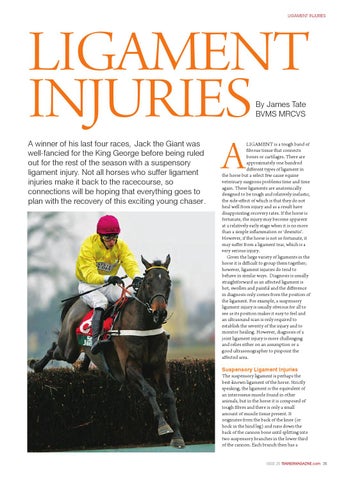LIGAMENTS.qxd:Jerkins feature.qxd
24/2/09
21:27
Page 1
LIGAMENT INJURIES
LIGAMENT INJURIES By James Tate BVMS MRCVS
A winner of his last four races, Jack the Giant was well-fancied for the King George before being ruled out for the rest of the season with a suspensory ligament injury. Not all horses who suffer ligament injuries make it back to the racecourse, so connections will be hoping that everything goes to plan with the recovery of this exciting young chaser.
A
LIGAMENT is a tough band of fibrous tissue that connects bones or cartilages. There are approximately one hundred different types of ligament in the horse but a select few cause equine veterinary surgeons problems time and time again. These ligaments are anatomically designed to be tough and relatively inelastic, the side-effect of which is that they do not heal well from injury and as a result have disappointing recovery rates. If the horse is fortunate, the injury may become apparent at a relatively early stage when it is no more than a simple inflammation or ‘desmitis’. However, if the horse is not so fortunate, it may suffer from a ligament tear, which is a very serious injury. Given the large variety of ligaments in the horse it is difficult to group them together; however, ligament injuries do tend to behave in similar ways. Diagnosis is usually straightforward as an affected ligament is hot, swollen and painful and the difference in diagnosis only comes from the position of the ligament. For example, a suspensory ligament injury is usually obvious for all to see as its position makes it easy to feel and an ultrasound scan is only required to establish the severity of the injury and to monitor healing. However, diagnosis of a joint ligament injury is more challenging and relies either on an assumption or a good ultrasonographer to pinpoint the affected area. Suspensory Ligament Injuries The suspensory ligament is perhaps the best-known ligament of the horse. Strictly speaking, the ligament is the equivalent of an interosseus muscle found in other animals, but in the horse it is composed of tough fibres and there is only a small amount of muscle tissue present. It originates from the back of the knee (or hock in the hind leg) and runs down the back of the cannon bone until splitting into two suspensory branches in the lower third of the cannon. Each branch then has a
ISSUE 25 TRAINERMAGAZINE.com 35
